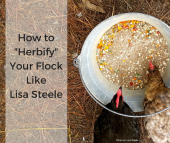










 1
1

















Owner, Etta Place Cider




George Hayduke wrote:Good article but the single biggest omission is not mentioned auto-sexing chicken breeds. If you have auto-sexers (Cream Legbars, Bielefelders, etc.) you can determine the gender of your chicks on Day 1 and cull the roosters. This saves the homesteader a tremendous amount of wasted effort and feed. These breeds were only recently introduced in the US but should be at the top of the list when considering which breed to select.
Moderator, Treatment Free Beekeepers group on Facebook.
https://www.facebook.com/groups/treatmentfreebeekeepers/









“The most important decision we make is whether we believe we live in a friendly or hostile universe.”― Albert Einstein











Owner, Etta Place Cider









|
Slideshow boring ... losing consciousness ... just gonna take a quick nap on this tiny ad ...
Get 100+ homestead tools in one software suite - works offline
https://homestead.tools/
|




